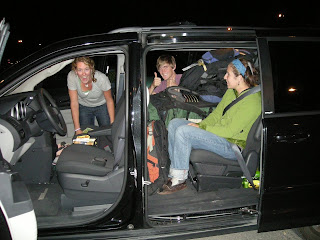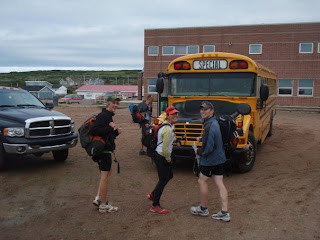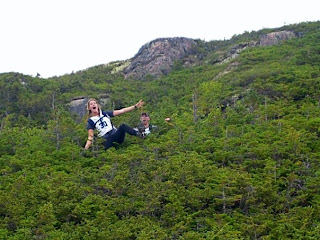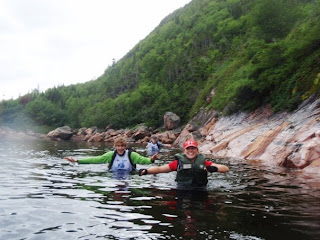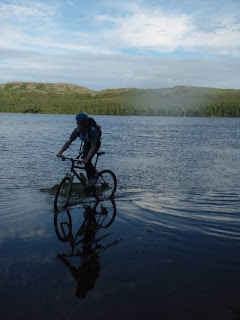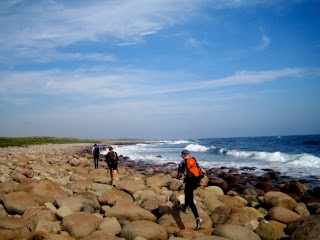Race Report: Coast Raid
The 2008 Coast Raid was without a doubt the hardest thing, physically, I’ve ever done. Four days of mountain biking, kayaking, intense trekking, orienteering, and ropes courses made for some serious “type two” fun. For those unfamiliar, “type two” fun refers to activities that are not actually that fun while you’re engaged in them, but in retrospect, are really fun to look back on. The Coast Raid is a prime example.
But let me back up. Before the race even started, our team undertook an adventure in itself in the form of the journey to Blanc-Sablon. After arriving in Deer Lake, Newfoundland and retrieving our rental bicycles from Cycle Solutions in Corner Brook, we loaded up the van to the brim. However, one thing was missing - our fourth teammate, who was arriving on a later flight. Somehow we managed to squeeze another body and her associated gear into the van.
Somewhere along the way (maybe it was over dinner and a Black Horse at the local dinner haunt in Deer Lake) we decided the best way to catch the ferry the next morning (four hours away in St. Barbe) was to drive straight to St. Barbe immediately, through the night.
There were three amazing things about the trip that ensued. The first was the fact that the main road to get there, Route 430, is also known as the “Viking Trail,” presumably because of Newfoundland’s past history of Vikings. There are few things that pick you up at 1 in the morning like seeing a sign for the Viking Trail and realizing that you are on said Trail. The second was the pit stop amid some very misty weather at two in the morning along a particularly desolate stretch of Newfoundland’s coast. The pit stop was made possible by amazing item number three, which was that in the course of the four hour drive, we saw exactly six other cars on the road. Newfoundland is remote.
After a fairly restless night, we boarded the ferry for Blanc-Sablon. Stormy conditions took over about halfway across the channel, and worsened on the short drive from the ferry dock in Blanc-Sablon to the school that would serve as the race check-in headquarters. The irony was palpable as we made several mad dashes to transport all of our gear from the car to the school’s gym without getting it wet, knowing full well that if tomorrow’s weather turned out like today’s, our efforts would have been in vain.
By the afternoon, however, the sun had come out, so we seized the opportunity to take a quick ride to test out the bikes and take in the beautiful scenery we’d be experiencing over the next four days.
As the other teams came in, we began to slowly gather bits of information about the race.
-
We’d be staying in a different town each night, most of the time based at the local school, and could expect to be racing for about 11-14 hours each day, including a night section.
-
Most of the other teams at the race were professionals or sponsored in some capacity; and they all looked like they had done this before. Yikes.
-
The majority of the water on the course was completely drinkable, without any purification (minus the sea water of course).
-
The first event the next day was to be kayaking; we then paid close attention to the demos on how to properly inflate the kayaks.
After receiving our formal race briefing, the race maps, and our itinerary for day one (as well as a welcoming song - very Quebecois I’m told), we cooked a team dinner over our stove and got some stories from the school’s janitor about the town.
The next morning saw another early wake-up call to get on the “special” school bus that would take us to St. Paul for the start of the race, about a 90 minute ride from Blanc-Sablon.
The race organizers wisely decided to make the first kayak inflation off the clock, so after we arrived in St. Paul, we were able to take our time getting set up, chat with the other racers (and, unbeknownst to us at the time, the mayor of the town), pose in front of the media helicopter, and test out the water temperature (a balmy 9 degrees C).
After a few words from the organizers and a countdown in French, we were off! The first kayak leg went smoothly if slowly, and after a few miles to wake us up, we were hoisting the kayaks onto our shoulders for the first portage. I got about three steps here before twisting an ankle in the bog (this will become a theme) and going down hard on a rock, opening a nice gash in my knee. We pressed on, however, and after a few more carries and another long paddle, we arrived at the first transition of the day, ready to drop the kayaks and head overland to the first checkpoints.
We hit the first incline hard and had actually pulled ahead of the other four- person mixed team by the first P.C. (Point de cheque, or checkpoint). We would trade leads with them throughout the rest of the day. It was quickly apparent that the trekking portions would be over some really tough terrain. Just about any path off the ridge line meant that with every foot plant you sunk down to mid-ankle at least. We stayed high as much as possible, but much of the time it simply wasn’t to be. These stretches were punctuated by swaths of undergrowth: thick, spiny, and unforgiving, ranging in height from mid-thigh to over our heads. These can really slow a team down.
This first day would also see our introduction to “coastering,” which is similar to trekking except it’s done along the coast, sometimes over some very sharp rocks and other times mostly in the water, if that happens to be the fastest way across a bay. It can get you pretty wet and sometimes turns into full-on swimming. In very cold water.
Speaking of new sports, here’s another one we did on the first day. It doesn’t have a cool name like “coastering,” but it’s pretty fun, and in some cases much faster than the alternative of riding your bike over crappy trail or on the beach. It’s called riding your bike through a lake.
At the race briefing the previous night, we had been informed that each day would have an “extreme” section with additional checkpoints. In order to attempt it, you had to finish the normal course before a certain time, to prevent teams from racing well into the night. Teams not attempting the section would be assessed a four-hour penalty. The race organizers made the mistake of saying that they only expected one quarter of the teams to qualify for the section, which meant that everyone was gunning for it from the get-go.
So when we finished the regular course with an hour and a half to spare on the cutoff, the choice was clear. We headed back to our kayaks and out to an island to hunt down the three “extreme” checkpoints. We wound up getting back pretty late, well after dark - but we had done it! The Extreme Coast Raid – Day One. Of four. Uh oh.
We ate dinner and plotted the checkpoints for the next day in haste in order to get as much sleep as possible for day two.
Day two was by far our toughest day. We had all done previous races of 12 hours, but nothing longer, so it was a new experience for all of us to get up the day after a really tough race and do another one. After a bike to our kayaks, we trekked our way around an island for the next four PCs. Our somewhat lagging energy was buoyed by a more relaxed pace and some stunning weather that served to accentuate the beautiful views we had already been experiencing.
We then kayaked back to the mainland to get a few more checkpoints and the Hike-A-Bike, wherein participants hike up a cliff with bikes in tow. It’s exactly as fun as it sounds.
Afterwards, however, we were rewarded mightily with a loooong downhill ride to the next transition: adventure swimming! The race officials informed us that we had a choice between actually swimming across the bay or trekking around it to get the last checkpoint of the day. Assessing the situation for less than five seconds told us that the trekking would clearly be the fastest route (especially after accounting for the time to don and remove wetsuits), but goshdarnit, we brought these wetsuits over a thousand miles just for this, and we were going to use them!
Upon departing the transition (and leaving some puzzled locals in our wake), one of us made the remark that after the bike ride back to town, dinner awaits us - after we cook it, that is. Turns out we were mistaken. The locals in St. Paul, like all the locals up and down the lower north shore, seemed to think that this race was the greatest thing since sliced bread. As a result, they cooked for us - not sliced bread, but fresh seafood! We were welcomed with a feast and some very friendly faces, as well as the realization that we were, in the words of Bon Jovi, halfway there.
Day three was the journey from St. Paul to Middle Bay, population 35. In between stood some gnarly hills on the bike, a 1 km kayak portage, and a circumnavigation of yet another island. The home cooking in St. Paul had really revived us though, and we were also treated to more spectacular views (including a whale rib) and some great coastering:
We managed to roll in to the finish right around the cutoff for the extreme section (a vast improvement over day 2). We were greeted with MORE home cooking and the news that, with a population of just 35, Middle Bay did not have a school to speak of, so some of the teams, including ourselves, would be spending the night in the local church.
The night was to be a short one, however, as the teams headed out at 10 pm for the night racing stage. This turned out to be a strong suit for us (somehow): we were 10th out of 19 teams here, our highest place in an individual stage.
After a short four hours of sleep, it was time to tackle the final day. Opening with a bike ride to the kayaks, we bid our inflatable friends adieu, but not without a tense fifteen seconds - I’ll just say that there’s nothing to get your heart rate up like the sound of an inflatable kayak deflating when you’re in the middle of the water and not really close to any shoreline.
After a long trek along the coast, were were back on the bikes to a Tyrolean pit stop:
After hopping back on the bikes, we started seeing signs for Blanc-Sablon again, but the wind off the ocean was becoming an increasingly angry nemesis. The first three bike PCs were inland, which offered a little respite, but the final two checkpoints of the race were directly on the coast and by this point the wind was absolutely howling. Someone said it was gusting to 60 kph, and I believe it - it was nearly impossible to ride in a straight line, even after we had secured the final PC and got back onto the gravel road back to town.
The excitement built quickly with our speed on the bikes as we progressed to smoother and smoother roads and the sounds of cow bells and cheering entered our periphery. The final 50 meters to the finish were uphill through a gravel playground, but we were determined not to walk our bikes through the chute. I continued my tradition of spectacular finishes by (accidentally) wiping out and diving across the line. There are several photos of this but I haven’t been able to get my hands on one. We did get a great team shot though, with our representative Canadian holding the American flag:
Almost immediately we were handed a 40 ounce bottle of Bud. I’m not sure what NASCAR is thinking with the milk thing – this is a far superior way to end a race.
From there the recovery began in earnest. Later on that evening we were awarded a “special” prize for being the team with the most smiles on their faces throughout the race, which came with some sweet hats and t-shirts from Endurance Aventure, “for people wilder than average.”
With a final time of 55 hours, 46 minutes and 11 seconds, I think we earned the description.
